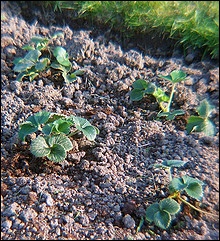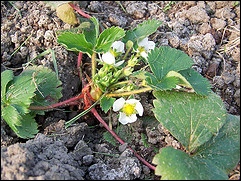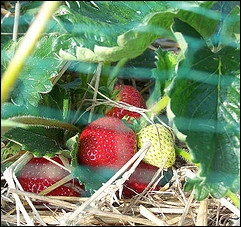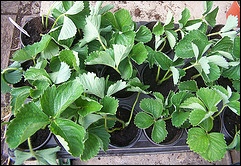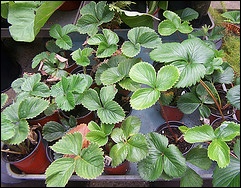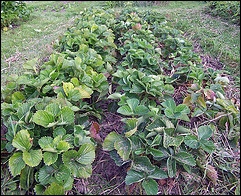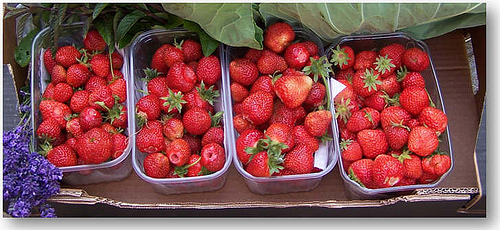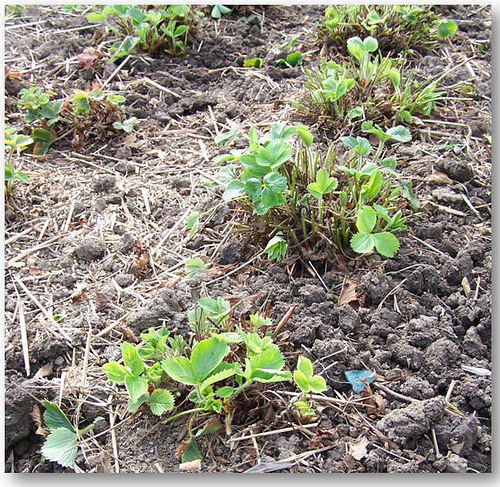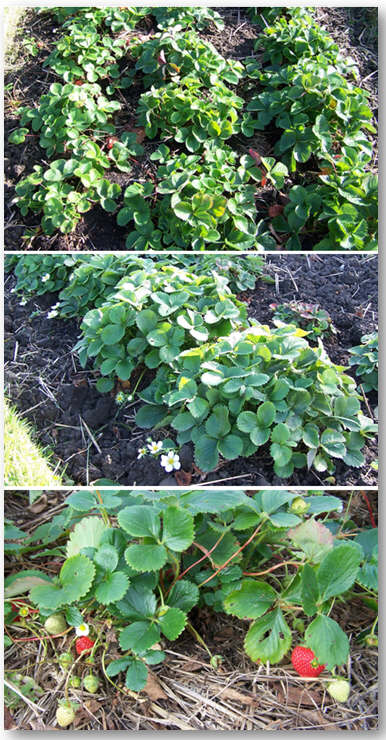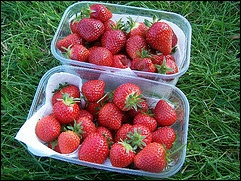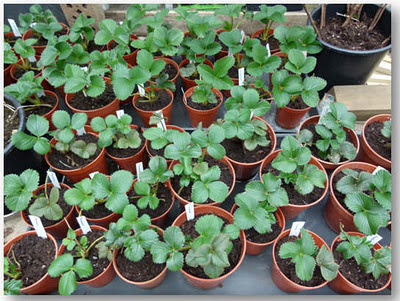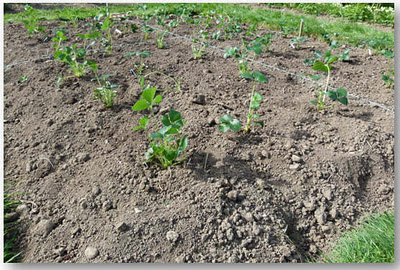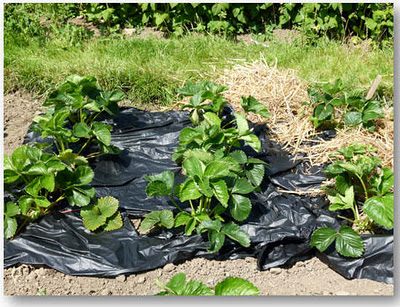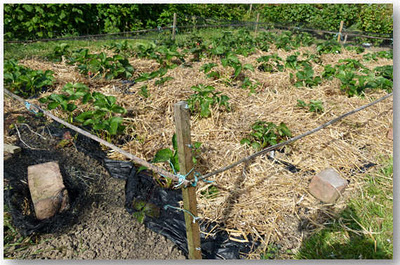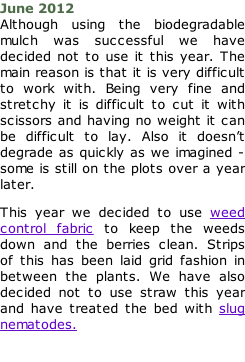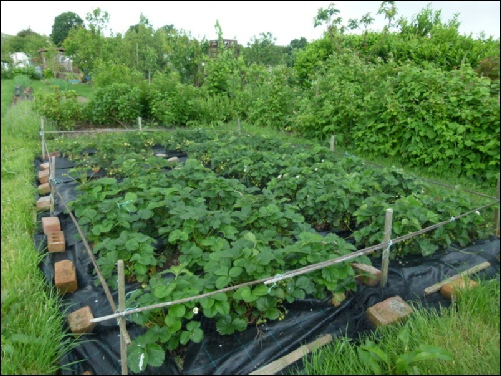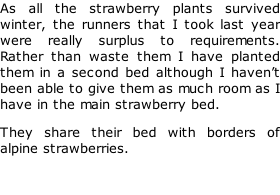


Our Plot at Green Lane Alloments Blog | Our Weather Blog | School Vegetable Patch Website | School Vegetable Patch Blog
© Our Plot on Green Lane Allotments -
Top Tip:
If you find a strawberry that has been nibbled by slugs, don't remove it. If you leave it on the plant then the slug will return to eat more of this berry and not move on to another victim. When I read this I was sceptical but it worked -
Want more strawberries next year?
On April 1st this year we planted three types of strawberries in a new strawberry bed. We chose varieties, Mae, Marshmello and Florence to hopefully provide a succession of berries. The plants actually arrived in autumn of last year but were kept in pots in the greenhouse until we were ready to plant them. (See 'Delicious’ strawberries in June article')
By the 15 April things were looking good as the plants began to flower. In May it was looking even better when huge shiny berries began to form
These were netted against birds who can spot even the tiniest patch of red on a strawberry from miles away. Straw was also placed around the plants to keep the berries off the soil and hopefully give some protection from slugs. If the birds don't get to the ripe berries then the slugs will try and I didn't want to share.
We had some delicious berries with the promise of a good crop until the rains came and consequently ruined many of the berries. We had to gather and compost most of the spoilt berries which was a huge disappointment especially as the berries still had the mouth-
Despite the foul weather, the plants continued to flourish and hopefully will give us a good crop next year – weather permitting. With this thought in mind I decided to tidy up the plants and plant some of the runners to increase the number of plants next year by creating a second bed.
Some articles suggest that you can just leave the plants to cast out runners to root wherever they like producing what they call mass planting. Tidying up strawberry plants does take a bit of time but I think that it is well worth the effort. In my opinion left to their own devices strawberry plants are like children and just run wild, become unruly and mix with the wrong sort. We made this mistake with a previous strawberry bed where runners just ran and rooted. The plants became clogged up with weeds which were impossible to remove without uprooting the strawberry plants.
It is recommended that the latest that you should do this is the first week in September so the end of August when I decided to add to our stock was just fine. As previously mentioned we have three varieties, Mae, Marshmello (the children on site actually thought we were growing marshmallows!) and Florence, so it was important when removing runners, for potting up, that care was taken to trace which plants the runners originated from.
Each runner was detached from the parent plant and the plantlet (they are actually referred to as daughter plants!) nearest to the parent was planted in a pot to provide a new plant for next year. Several plantlets may form along a runner but only take the first plantlet when propagating new plants as this is the one with most strength and vigour and will provide a better plant than the plantlets further away from the parent.
The selected plantlet was trimmed of any small leaves at the base and planted into a pot of compost. It will probably start to flag a little until it settles down into its new environment and starts to make roots.
Hopefully the newly potted plants will root successfully (as the ones taken a little earlier and shown on the right did) and we will have almost three times as many plants next year. The plants will be overwintered in a cold greenhouse to give them a good start . That is as long as we remember to water them.
Many articles recommend that plantlets are rooted in pots in situ alongside the parent plant and the runners cut free after rooting, however we prefer to propagate as described above. Pegging the runners into pots means that without close attention the pots can dry out. Digging holes in which to sink the pots disturbs the parent plants and they are further disturbed when trying to dig up the pots once the runners have rooted.
Once all the runners were removed from the strawberry bed, I scraped away all the straw used to protect the fruits, weeded between the plants and loosened the soil a little.
Over winter the leaves of the plants may look dead but new growth should start in spring at which point the dead leaves can be removed. Apparently the more leaves that a strawberry plant grows then the more berries it produces. Some articles advocate cutting all the leaves off the plants after fruiting to encourage leaf growth but I am too much of a coward to do this.
Update 2009 season:
We had a bumper harvest of strawberries during 2009 although some varieties did better than others. Mae seemed to have almost disappeared -
Marshmello was loaded and Florence also produced a good crop. There were very few runners produced by Florence and so we had less of these than other varieties.
We planted a row of Flamenco which is a perpetual fruiting variety and is in August still producing a few fruits.
When fruiting was over and the plants began to look shabby and uncared for I began the process of tidying the beds. On 8 & 9 August I tackled the first bed. As before I removed the straw to the compost heap and cleared any weeds.
I noticed lots of young leaves growing amongst the remaining old leaves and so decided that this year I would be braver and removed all but the new growth. I wasn't quite brave enough to use shears or a strimmer as some gardeners do, instead I used a pair of scissors to ensure that any new growth wasn't damaged.
The soil has been loosened and a sprinkling of concentrated farmyard manure will be applied. (Any fresh manure is being avoided for the foreseeable future due to potential contamination).
I was hoping to increase our stocks of Florence and Flamenco by propagating some runners, however as last year Florence hasn't produced any yet.
Update 10 October 2009
The above treatment worked so well that we now have a healthy show of new leaves and are still gathering fresh strawberries. The plants are still producing lots of flower but I expect the frost will soon put paid to that. However, it's good to note that the plants are flourishing and may repeat the bumper crop that we enjoyed this year.
2011
Our old strawberry beds have now become less productive and infested with weeds so this year we decided to set up a new strawberry bed. As our old strawberries had become mixed up we couldn't be sure which variety was which so we decided to invest in new plants.
We bought four varieties Marshmarvel (early), Marshmello (main), Amelia (late) and Flamenco (perpetual). Theses four varieties should give us an extended fruiting season.
Once the plants arrived they were potted up and kept in the cold greenhouse.
Once the plants arrived they were potted up and kept in the cold greenhouse.
The new bed was divided into quarters so that we could keep the varieties apart and planted up in April.
Once the berries started to ripen it was time to protect the fruits. In the past we have always used straw to mulch but I think that the weed seeds in the straw are partly responsible for the masses of weeds that eventually become impossible to control and smother the beds. We needed an alternative but didn’t want to use a permanent weed suppressing material. Then we came across a new biodegradable mulching fabric. It’s made from plant starch and it is claimed that this will last 16 weeks before being broken down. We decided to give this a try. We covered the bed with the material cutting crosses to allow the plants to be popped through. The fabric is extremely light and so we decided to use the straw on top of the mulch to weight it down. Hopefully we will be able to remove the straw after fruiting and before the mulch disappears.
Obviously the mulch doesn’t protect against eagle eyed birds and so the entire bed has been covered with netting.
This year I will remove as many of the runners produced as I can keep up with. I want to try to ensure that all the young plants energy goes into building a strong plant and good fruit. The plants have other ideas and are producing runners as fast as I can remove them.
We also bought a few plants of a perpetual variety called Finesse which have been planted in a trough in the garden to give ready access to -
